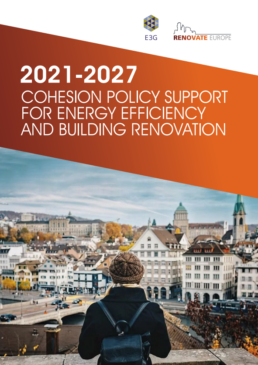About this Study
This study looks into how EU member states plan to use cohesion policy funding to support renovation and draws attention to key actions to maximise impact.
An estimated €20bn are programmed for energy renovation and energy efficiency. With co-financing from member states, this could could reach €29bn.
This is an important contribution to financing renovation. However, these funds alone cannot cover the investment needed to meet the 55% emissions reduction target for 2030.
In the run up to 2030, the new cohesion funds will be used alongside the Recovery and Resilience Facility (RRF) to support the delivery of renovation investments across the EU. RRF and cohesion funding combined will provide over €66bn for energy renovation across the EU until 2029.
To achieve maximum impact of this unprecedented quantity of EU money, effort must be made to use the funds as efficiently as possible. To do so members states should focus on:
- Attract and leverage private finance while targeting grants where they are most needed
- Ensure careful coordination with other (EU) public funds
- Monitor programme implementation and address delivery bottlenecks
*The Country Factsheets Annex is being updated and will be reuploaded soon!
Highlights of the study
A total of 175 programmes across the EU contain energy renovation or energy efficiency investments in public infrastructure, housing, or businesses*. Funding is typically allocated to a mix of interventions including building envelope improvements (e.g. loft, cavity and wall insulation), heating source replacement, connection to heat/cooling networks or renewable energy equipment as well as installation of energy efficient lighting. For enterprises, financing can also be used to improve the efficiency of commercial and industrial production processes (e.g. efficient cooling equipment).


- €10.6bn is allocated to renovation and energy efficiency projects in the public sector.
- €6.5bn of EU funds is earmarked for energy renovation of the housing stock.
- €2.9bn is allocated to enterprises subject to energy efficiency requirements.
At this stage of programme development, it is not possible to disaggregate the exact volume of funding for building renovation from that allocated to other activities within relevant programmes.
There are, however, clear delivery targets for renovation in the housing and public sectors. The funding is expected to lead to 723,000 renovated dwellings across the EU and 33 million m2 of renovated floor area of public infrastructure. The Renovation Wave calls for renovation of 35 million units by 2030.
Of the €20bn EU funds, three quarters (€15.3bn) will go to projects subject to minimum energy savings criteria. Such projects would need to achieve at least medium depth renovation (primary energy savings of over 30%; or for public sector, realise greenhouse gas emission savings of over 30%). Per segment, this includes 65% of funding for the housing stock; 78% of funding for public infrastructure. Only projects subject to such requirements in the enterprise sector were included in this study. While projects with minimum standards will contribute to boosting the energy renovation rate, the minimum standards are well below the 60% energy savings required for ‘deep’ renovation*.


The proportion of eligible cohesion policy funding that is programmed for renovation or energy efficiency projects varies from 0% (DK) to 26% (IE)*. In absolute terms, Poland (€4.4bn), Spain (€2.2bn), Italy (€1.5bn) and Portugal (€1.4bn) have planned the highest volume of funds for renovation or energy efficiency. These are some of the member states that receive the largest allocations of cohesion policy funding. Half of member states have prioritised investments in the public sector (14); residential investments account for the largest share of funding in 10 member states.
Member states have provided overall more funding for energy renovation through the Recovery and Resilience Facility (RFF, approx. €46 bn across 18 MS*). Across those member states, planned RRF investments are concentrated in the residential sector, which receives over €23bn (58%) of funding.
Click here to find out more about RRF funding for building renovation and the buildings-related measures in the National Recovery and Resilience Plans (NRRPs).
Key recommendations to maximise the potential of cohesion policy funds for energy renovation
- Attract and leverage private finance while targeting grants where they are needed the most. Cohesion policy funding can play an important role in leveraging private capital through enhanced use of financial instruments and coordination with financial institutions such as development banks.
- Ensure careful coordination with other (EU) public funds. There is an unprecedented volume of public investment in the EU as a response to the impacts of the Covid-19 pandemic and war in Ukraine. Ensuring different sources of funding are complementary will be vital.
- Monitor programme implementation and address delivery bottlenecks. Publicly funded projects offer a unique opportunity to drive high quality standards across the renovation sector.



